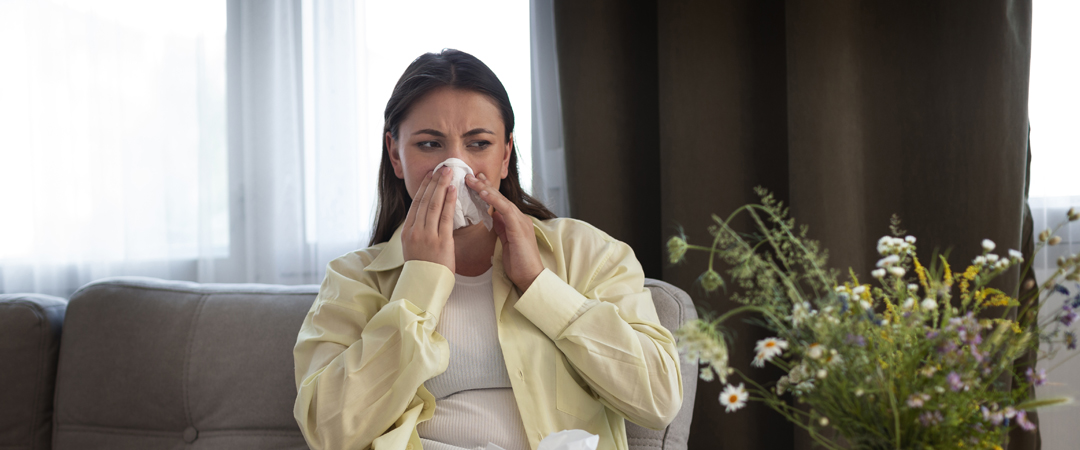
Allergic rhinitis is a common condition that can cause symptoms such as sneezing, itching, and nasal congestion. In this comprehensive guide, you will learn everything you need to know about this condition, including its causes, symptoms, and the treatments available to relieve the symptoms.
What is allergic rhinitis?
Allergic rhinitis is an inflammation of the nasal lining caused by an allergic reaction to substances such as pollen, dust mites, mould, or animal dander. Common symptoms of allergic rhinitis include sneezing, itching, nasal congestion, and a runny nose. This condition can be treated with antihistamines, decongestants, and nasal corticosteroids.
Non-seasonal allergic rhinitis
Non-seasonal allergic rhinitis, also known as non-seasonal rhinitis or perennial allergic rhinitis, is a long-term (chronic) condition characterised by inflammation of the nasal lining, recurrent sneezing, itching, and nasal congestion. It is caused by allergies to indoor or outdoor allergens such as pollen, dust mites, animal dander, and mould spores.
Seasonal allergic rhinitis or hay fever
Seasonal allergic rhinitis, or hay fever, is a condition that causes sneezing, nasal congestion, and itchy eyes. Symptoms usually last around two weeks but can be severe enough to interfere with daily life.
Seasonal allergic rhinitis is caused by pollen from trees, grasses, or weeds. Each type of pollen triggers a different reaction in the body.
The symptoms of allergic rhinitis.
The symptoms of allergic rhinitis include sneezing, itching, nasal congestion, and a runny nose. Sneezing often comes in bursts and may be accompanied by itching in the nose, throat, and eyes. Nasal congestion can make breathing difficult and may also cause headaches and fatigue. A runny nose can be clear and watery or thick and yellowish, depending on the severity of the allergic reaction. If you experience these symptoms, it is important to consult a doctor for proper diagnosis and treatment.

The causes
Allergic rhinitis is caused by an allergic reaction to substances such as pollen, dust mites, mould, and animal dander. When these substances enter the nose, the immune system reacts by producing histamine, which triggers the symptoms of allergic rhinitis. People with a family history of allergies are more likely to develop allergic rhinitis, as are those with a history of asthma or eczema. Other factors, such as air pollution and smoking, can also worsen the symptoms.
The consequences of allergic rhinitis
The effects of allergic rhinitis vary from person to person. The severity of symptoms can also differ from season to season or over time.
Some people with allergic rhinitis experience only mild symptoms and can continue their normal activities without difficulty. Others may have more severe symptoms that impact their quality of life and limit their ability to participate in certain daily activities.
Potential complications include:
Infection. Allergic rhinitis can make you more susceptible to infections, including viruses such as the common cold or influenza (the flu). This may occur because your nasal membranes are swollen or inflamed, making them more vulnerable to infections. Additionally, an increased production of mucus can create an environment conducive to the growth of germs (bacteria).
Allergic conjunctivitis (pink eye). Allergic conjunctivitis is an inflammation of the conjunctiva – the transparent layer covering the white of the eye (sclera) and the inside of the eyelids. It is usually caused by an allergic reaction but can also be triggered by irritants such as smoke or dust particles. Symptoms include redness, itching, and watery eyes. In more severe cases, it can cause crusting on the eyelids resembling scales, swelling around the eyelid, and irritated eyes.
Treatments
There are several treatments available for allergic rhinitis, including antihistamines, decongestants, nasal corticosteroids, and allergen immunotherapy. Antihistamines block the histamine produced by the immune system, thereby reducing symptoms. Decongestants reduce inflammation and nasal congestion, while nasal corticosteroids alleviate inflammation and associated symptoms.
Allergen immunotherapy, also known as desensitisation, involves gradually exposing the patient to increasing doses of allergens to reduce the allergic reaction. It is important to consult a doctor to determine the most appropriate treatment for your case.
Allergen desensitisation
Allergen desensitisation (also known as immunotherapy or desensitisation therapy) is a type of allergy treatment that aims to increase tolerance to the allergen. Allergy shots are one way to achieve this, but there are other methods as well.
Allergic reactions occur when the immune system responds to something it perceives as dangerous, such as pollen or peanuts, even though it is actually harmless. This reaction can cause symptoms such as sneezing, itching, and a runny nose.
Allergen desensitisation can help allergy sufferers reduce their sensitivity to certain foods or substances. It typically involves receiving injections containing small amounts of the allergen over time, until your body no longer reacts negatively.
How to prevent allergic rhinitis
Although it is not possible to completely prevent allergic rhinitis, there are steps you can take to reduce your risk of developing symptoms. Avoid known allergens that trigger your allergic rhinitis, such as dust mites, mould, pollen, and pet dander. Keep your home clean and well-ventilated, use air filters, and encase mattresses and pillows in dust mite-proof covers. Avoid irritants like cigarette smoke and strong chemicals. If you are allergic to a specific food, avoid it as well. Lastly, if you have a family history of allergic rhinitis, speak to your doctor to determine if you should be tested for allergies.
Interactions between asthma and allergies
Asthma and allergies are two conditions that can be linked. Asthma is a chronic respiratory condition that causes inflammation and obstruction of the airways. Allergies occur when the body has an abnormal immune response to substances called allergens, which are generally harmless to most people. If you have asthma, you are more likely to develop allergies, although the exact reason is not fully understood. This may be due to shared factors, such as genetic predisposition or environmental triggers. It is possible for asthma and allergies to coexist, but this is not always the case. For instance, a person with asthma may not experience any allergy symptoms, and someone with allergies may not have asthma symptoms. However, individuals with both conditions may experience more severe symptoms compared to those with only one condition. The treatments for asthma and allergies differ, but some medications used for one condition can also help manage the other, as they reduce inflammation throughout the body (not just in the lungs).
You ask, our teams answer.
F.A.Q
Yes, allergic rhinitis can be seasonal (hay fever), triggered by seasonal allergens such as pollen, or perennial, caused by allergens present year-round, such as dust mites, mould, or animal dander.
Some people find partial relief from their symptoms through natural remedies such as saline nasal irrigation, using HEPA air filters, and managing their environment to reduce allergens.
Angioedema is a very rare condition that causes swelling of the skin. The swelling usually appears suddenly and often affects the legs, hands, lips, or tongue. It can be painful but is not life-threatening.
Causes of Angioedema
The exact cause of angioedema is unclear. It is thought to be caused by an allergic reaction, although some people have no apparent history of allergies. In some cases, there may be a family history of angioedema.
Angioedema can occur at any age but is more common in adults over 50. It tends to be hereditary.
What are the symptoms of angioedema?
The main symptom is swelling of a part of the body, usually the face or limbs (arms and legs). Symptoms typically appear suddenly and last less than two hours before disappearing entirely. The swelling can range from mild to severe and may affect a single area or multiple areas at once (generalised angioedema). You may also experience:
- itching or a burning sensation around the affected area
- redness around the affected area
- chest pain that worsens when you take a deep breath (pleurisy)
Allergies can cause numerous problems for both adults and children. In many cases, allergies are treated with medications, such as antihistamines, which help reduce symptoms. However, in cases of severe allergies, it may be necessary to follow a medical treatment known as allergen avoidance.
What is allergen avoidance?
Allergen avoidance is a procedure that involves removing cat or dog allergens from the home environment to alleviate symptoms of allergic rhinitis (hay fever). This method has been shown to reduce allergic rhinitis symptoms by up to 90%.
The most common way to remove allergens is by vacuuming and dusting. Allergens can also be eliminated by washing bedding and clothing in hot water, cleaning pet beds with bleach solutions, and replacing carpets with hardwood or tiled flooring covered by rugs.
The aim is to remove any traces of cat or dog dander from the home environment so there is no longer any contact between individuals and the allergens that trigger their symptoms.
If left untreated, allergic rhinitis can lead to complications such as chronic sinusitis, upper respiratory tract infections, sleep loss, fatigue, and a reduced quality of life.
If you have persistent symptoms of allergic rhinitis that are affecting your quality of life, it is advisable to see a doctor. A healthcare professional can help identify the cause of your symptoms and develop an appropriate treatment plan.
The hereditary component of allergic rhinitis has been established in several studies. The prevalence of allergic rhinitis is higher among first-degree relatives of patients with allergic rhinitis than among control subjects. Furthermore, monozygotic twins show a higher concordance rate for allergic rhinitis than dizygotic twins, suggesting a genetic basis for the development of this condition.
The familial aggregation of atopic disorders has been attributed to the polygenic nature of these diseases and shared environmental factors. These include exposure to allergens and infectious agents during early childhood [8]. However, the role of genetic factors in atopic disorders is likely more significant than previously thought.
Several researchers have demonstrated an association between polymorphisms in genes encoding proteins involved in immune regulation and allergic disease. The most studied gene is filaggrin (FLG), which encodes a protein essential for the formation of sweat pores on the skin’s surface. Several different mutations affecting FLG have been identified in patients with ichthyosis vulgaris (IV) or atopic dermatitis (AD). Furthermore, FLG variants have been associated with AD or asthma in some studies, though not in others.

